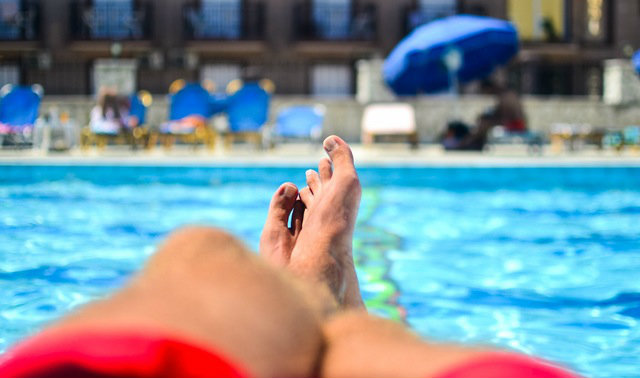
Let me start this by saying: I’m fine. I don’t want my friends and relatives to read this and say “I had no idea!” and then send me a card or start a prayer chain on Facebook.
Everyone has struggles. Luckily for me, mine aren’t debilitating. One of these struggles is just a trait I’ve learned to live with in my thirty-plus years on this spinning orb — but living with it became much easier after participating in the Whole Life Challenge.
Professionals call it “body dysmorphic disorder,” or BDD. I call it, “Please for the Love of All That Is Holy, Don’t Make Me Take My Shirt Off,” or PFTLOATIHDMMTMSO. People with BDD are often unlikely to speak about it. Who really wants to talk about their body issues? What’s an appropriate venue for that, the office lunchroom? And who are you actually allowed to talk to if the issues are possibly born more of your own perception than they are real? I once tried to explain my perspective to a friend by saying, “You don’t understand, I used to weigh over 200 pounds.” Fun fact: that friend weighed over 200 pounds.
When I enrolled in my first Whole Life Challenge, I saw it as another possible avenue for weight loss. “Finally, a diet plan by people I trust! I can get rid of these ridiculous love handles and look myself in the mirror!” What I found it to be was something entirely different, and effective in a very unexpected way.
What Is Body Dysmorphic Disorder?
The Anxiety and Depression Association of America defines BDD as “a body-image disorder characterized by persistent and intrusive preoccupations with an imagined or slight defect in one’s appearance.” You might read that and think about something in yourself that you perceive as an imperfection, i.e. something you don’t really like. The difference between a normal self-image and having BDD is that with BDD, this preoccupation with a flaw – real or otherwise – occupies a large part of your day and possibly hours at a time.
Many people with BDD resort to any manner of “fixes” including excessive grooming, skin picking, avoiding or constantly seeking mirrors, excessive exercise, obsessively changing clothes, and sometimes even surgery. Patients often have to undergo cognitive-behavioral therapy in place of or while taking antidepressant medications. Sadly, those that go without treatment have been known to sequester themselves in their homes and many resort to suicide. And while cases of women with poor body image are more publicized, it also frequently occurs in men.
If any of this is resonating with you, I beg you to seek help from a trained professional. (One possible resource is the Anxiety and Depression Association of America)
BDD & Me: Learning to Live Together
In my post college years, I lived in an apartment community that had a pool. Generally speaking, I like pools and other various bodies of water. I can swim. But the thought of having to remove my shirt and expose the area of my back just above my waistline to friends and total strangers (some of them being single women) had me so pre-occupied that when they posted a flier for a pool party, I didn’t consume anything but water and grilled chicken breast for four straight days, all while doing crunches and side bends in my cubicle at work. We can sit here and armchair quarterback this silly lack of rationale all day, but suffice to say, it occupied far too much of my thinking and I wasn’t dealing with my concerns properly. (As it turns out, the party was rained out anyway.)

As a result of my BDD, I have been a sucker for any and all possible solutions. The fitness fad of targeted weight loss was an especially difficult time for me. “Do This One Movement to Burn Off Back Fat FOREVER!” I’d spend the $5.99 and abide by this paragraph-long, fickle-minded “fix” only to dig myself deeper and deeper into thinking less of myself physically because – SURPRISE, SURPRISE – it didn’t work (see above reference to cubicle side bends and crunches).
I was obsessed and I allowed myself to spiral into a never-ending stream of self-consciousness. “My BMI is far too high. What does the scale say? How do I have a flat stomach but these jiblets jibbling over my butt? I’m lifting weights every day – why isn’t this helping? Maybe I should try this ‘Hollywood Diet’ everyone’s doing. I could probably live through a twelve-day juice cleanse.”
When I focused on this kind of unfounded minutia, seriously ridiculous things started to surface. I’d go through months of feeling like a failure (usually sprinkled with some stress eating…and sprinkles) and the anxiety bled into other parts of my life in one way or another. Hindsight allowing clarity, I know now that my overall self-confidence obviously wasn’t where it should’ve been, I allowed work to consume an unhealthy amount of my time (probably hiding on some level), and I was spending far too much money on various possible fixes (mainly chemical-laden supplements).
The Whole Life Challenge
When I signed up for CrossFit, I frankly thought it was just another one of these possible “fixes.” My trainer had abs that seemed to extend from below his shorts all the way up to his adenoids. There was no way I’d get to that level, but I had a wedding coming up in a year and weddings have photographers and — you see where I’m going with this. Bloody hands and cautionary cult memes be damned, I had to be prepared.
That’s when I stumbled into a community dedicated to positive physical transformations and, eventually, the first Whole Life Challenge (I’m an OG WLCer, y’all). And for the first time, I understood all of my previous attempts at “fixing” myself to be completely and totally off base.
Once I got over the anxiety associated with the initial WLC weigh-in (“So on day one of the challenge, I’m going to my gym where a person I know and respect is going to put a measuring tape around the very area that preoccupies all of my anxiety???”), I found the discipline of the dietary guidelines and the daily exercise to be far superior to my previous daily/hourly anxiety checklist. I was able to embrace a regimen – a lifestyle – for a longer duration of time without the promise of instantaneous, unfounded results. And for the first time, I was surrounded by a group of people who were willing to have an open discussion about their personal journeys in achieving a healthy lifestyle.
Even further, I discovered something much more valuable and the true meaning – my meaning – of “whole life” took hold. Through the mobility and meditation practices, I discovered how I felt when I was truly behaving healthily. I discovered an ability to do a healthy self-check-in. That is to say, I discovered an introspection that the scale and the mirror can’t offer. I ignored the scale and I stopped buying stupid magazines and supplements. Checking in with myself regarding how I was feeling, rather than focusing on and criticizing my physical problem areas, became more natural. I even learned some self-love in the process.

A Healthy Conclusion
Now before you start thinking that I ended up with a V-shaped torso and abs for days, let me dispel that. I’m not there. You won’t find me on the cover of any magazines and I’m hardly a poster child for CrossFit. Not even close. That reality – my reality – is just fine.
Because now – even when I fall behind – I have a healthy view of my body and how it responds to my habits and actions while understanding that positive health is a life-long commitment. And I can’t even begin to express to you the amount of relief that yields.



